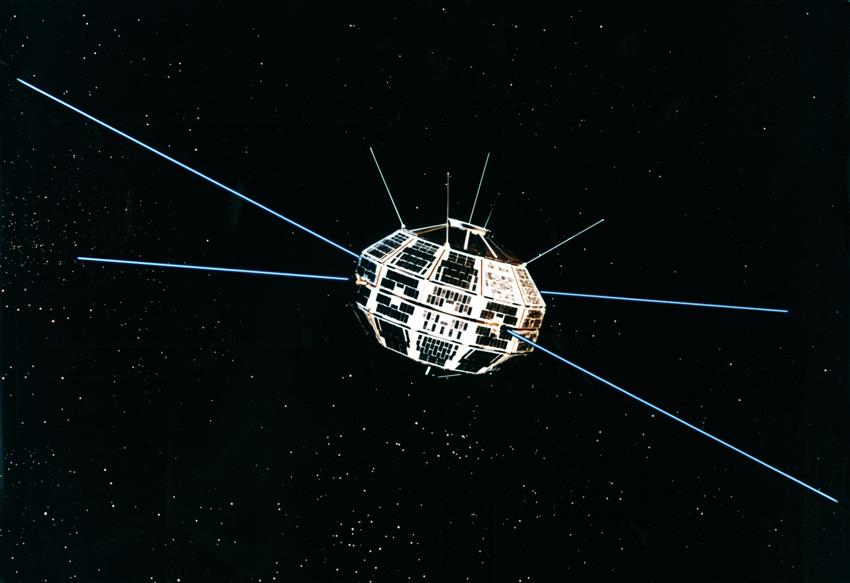Night at the Space Museum
Difficulty: Moderate
Duration: 2.5 hours + homework
Materials: Moderate
Background
Did you know that there is a field of expertise called space archaeology? Just like on Earth, humans have created lots of "stuff" that has been put into space. These items range from the very big to the very small, from historically significant to debris. There are more than 500,000 objects the size of a marble or larger circling Earth right now. The area where most of these objects reside is called low Earth orbit, or LEO. One historical example is Alouette I, the first Canadian satellite in space. Alouette I was launched in , making Canada the third country in space after the U.S.S.R. (now Russia) and the United States. Alouette I is no longer operational, but it is a testament to the beginning of the Canadian space program.
Humans have left objects on the Moon and Mars as well. Humans have left over 187,400 kg of material on the Moon. This includes tools, rovers, spacecraft landing gear, and personal mementos. On , the Indian Space Research Organisation (ISRO) sent a lunar orbiter to the Moon. The mission was called Chandrayaan-2 and also had a lander, called Vikram, and a rover, called Pragyan. Unfortunately, the lander lost communication and crash landed into the Moon. While this was not the desired outcome for this mission, there is now a valuable site on the Moon waiting to be studied by future space archaeologists.
Will there be outer space museums in the future? Remember, a museum is not just a giant building with lots of old stuff in it. A museum can be a park, a garden, a landscape, a town, or a number of other things. When museum workers (curators, interpretive planners, etc.) start planning a new exhibition, they often start with a main focus for the exhibition. Then, they research and plan around that idea to create something new, exciting, and enlightening.
This activity will challenge you to think about objects in space in a new way and consider how museum practices on Earth might translate (or not) in space.
Mission description
In this activity, participants will take on the role of museum curators in outer space. In groups, they will research a heritage object or site in outer space and create an exhibition around that object or site. Curators can decide whether they would like to build their exhibition in space (in LEO, on the Moon or on Mars) or bring an object back to Earth. The curators will present their exhibition to the rest of the group explaining why they chose this object or site, how they plan to preserve it, and what their exhibition will be about.
Timeline
| Breakdown | Duration |
|---|---|
| Background lecture | 35 minutes |
| Instructions | 5 minutes |
| Group activity | 30 minutes + homework |
| Presentations | 60 minutes |
| Wrap-up | 60 minutes |
| Total | 2.5 hours + homework |
Goals
To achieve a greater understanding of heritage objects in outer space and museum practices.
Objectives
By the end of this activity, participants will:
- Learn about the history of space exploration through objects
- Work collaboratively to create a museum exhibition
- Think critically about heritage objects in space
Mission preparation
Materials
The amount of materials needed for this activity is up to the discretion of the activity facilitator. Participants can create their exhibition with craft supplies, draw a layout of the exhibition, or describe it with words.
Participants will need access to the Internet or a library to research their heritage object (see below for some suggestions of objects and sites to research).
Mission instructions
- Use the information in the background section of this document to introduce the activity.
-
Talk to participants about their knowledge of museums with some guiding questions below:
- What is a museum?
- Have you ever been to a museum?
- What do you like / don't you like about museums?
- What would you change about museums?
- Have you ever seen a really good exhibition? What made it good?
- Have you ever seen a really bad exhibition? What made it bad?
- Divide participants into groups.
- Participants select a heritage object or site in outer space to be the "centrepiece" of their exhibition.
- Participants design an exhibition around the object or site.
- Participants answer the questions on the participant handout while reflecting on the choices the group made for their exhibition.
- Each group presents their project.
- Conduct a wrap-up, asking participants to share their thoughts on the activity and what they learned.
Suggested space heritage objects and sites
(This list is not exhaustive and is meant to offer a starting point for participants' in-depth research.)
- Alouette I
- RADARSAT-1
- Neil Armstrong's first footprint on the Moon
- Vanguard 1
- The International Space Station
- Apollo landing sites on the Moon
- Opportunity and Spirit rovers on Mars

